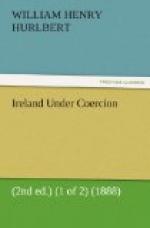visit of Mr. Davitt to the United States, Mr. Henry
George finally transferred his residence from San
Francisco to New York, and made his arrangements to
visit England and Ireland, and bring about a practical
combination between the advocates of “the land
for the people” on both sides of the ocean.
These arrangements he carried out in 1881-82, publishing
in 1881, in America, his treatise on the Irish Land
question, while Mr. Davitt, who had been arrested
after his return to Europe by Mr. Gladstone’s
Government in February 1881, on a revocation of his
ticket-of-leave, lay a prisoner at Portland. Mr.
George himself, while travelling in Ireland with an
academical English friend, came under “suspicion”
in the eyes of one of Mr. Forster’s officers,
and was arrested, but at once released. During
the protracted confinement of Mr. Davitt at Portland,
the utter incapacity of Mr. Parnell and his Parliamentary
associates to manage the social revolution initiated
by the founder of the Land League became fully apparent,
not only to impartial, but even to sympathetic observers
in America, long before it was demonstrated by the
incarceration of Mr. Parnell in Kilmainham, the disavowal,
under pressure, of the no-rent manifesto by Archbishop
Croke, and the suppression of the Land League.
In sequestrating Mr. Davitt, Mr. Forster, as was shown
by the extraordinary scenes which in the House of
Commons followed his arrest, had struck at the core
of the revolution, and had the Irish Secretary not
been deserted by Mr. Gladstone, under influences which
originated at Kilmainham, and were reinforced by the
pressure of the United States Government in the spring
of 1882, history might have had a very different tale
to tell of the last six years in Ireland and in Great
Britain.[6]
V.
It was after the return of Mr. George from Ireland
to New York in 1882 that the first black point appeared
on the horizon, of the conflict, inevitable in the
nature of things, between the social revolution and
the Catholic Church, which assumed such serious proportions
two years ago in America, and which is now developing
itself in Ireland. Among the ablest and the most
earnest converts in America to the doctrine of the
new social revolution was the Rev. Dr. M’Glynn,
a Catholic priest, standing in the front rank of his
order in New York, in point alike of eloquence in
the pulpit, and of influence in private life.
Finding, like Michael Davitt, in the doctrine of Henry
George an outcome and a confirmation of the principle
laid down in 1848 for the liberation of Ireland by
Finton Lalor, Dr. M’Glynn threw himself ardently
into the advocacy of that doctrine,—so
ardently that in August 1882 the Prefect of the Propaganda,
Cardinal Simeoni, found it necessary to invite the
attention of Cardinal M’Closkey, then Archbishop
of New York, to speeches of Dr. M’Glynn, reported
in the Irish World of New York, as “containing
propositions openly opposed to the teachings of the
Catholic Church.”




